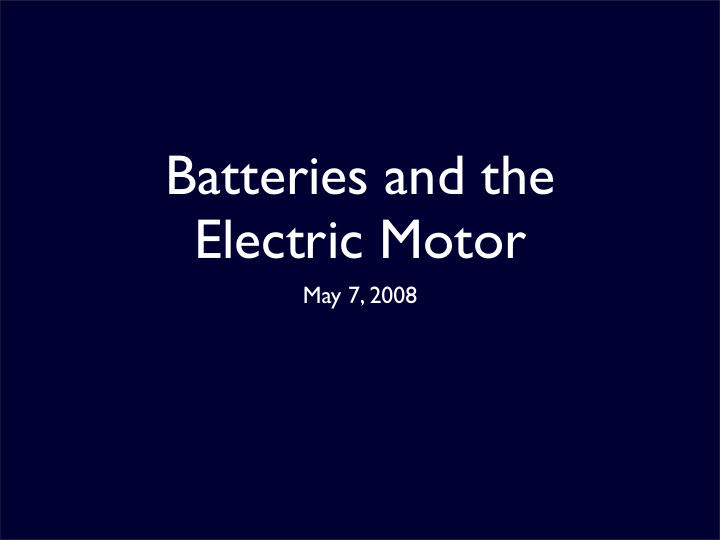



Batteries and the Electric Motor May 7, 2008
Announcements • Paper outline due tomorrow in class, at the beginning of class. • You will sign up for a meeting when you turn in the outline.
What is a battery? • An electrochemical battery , or an electrochemical cell, is a device in that stores chemical energy. • Chemical reactions convert this stored chemical energy into electrical energy.
Parts of a Battery • Cathode • Anode • Electrolyte = substance containing positive and negative ions • When battery is not connected to load (a car, a computer, a cell phone), reaction can’t take place. • When circuit is completed, chemical reactions release electrons that power electrical devices.
The Electrochemical Reaction • The anode is oxidized - generating electrons • The cathode is reduced - using up electrons • Electrolyte • Allows chemical reaction to take place • Makes sure all the charges balance out
The First Battery? • The Baghdad Battery - discovered in Iraq in the 1930s. About 2,000 years old.
The Voltaic Pile • The first electric battery was the Voltaic Pile , invented by Alessandro Volta in 1798.
Rechargeable Batteries • A primary cell is any cell in which the electrochemical reaction is not reversible. • Material in one or both electrodes is used up • In a secondary cell , the reaction is reversible. • Rechargeable battery can be restored to full (or almost full) charge. • E.g. Lead Acid, NiMH, NiCd, Li-ion
The Lead-Acid Battery
Next-Generation Batteries • What factors are important? • Energy density: amount of energy stored per unit mass, and unit volume • Rapid charging • Cost • Lifetime • Safety
Lithium-Ion Battery • Rechargeable • No memory-effect • One of best energy-to-weight ratios • Slow loss of charge when not in use • Lifetime depends on manufacturing date, not usage • Safety: can explode when exposed to high temperatures
Which battery will win?
Converting Electrical Energy to Mechanical Energy • Batteries convert chemical energy to electrical energy... • How can we use this electric energy to make an electric car move?
Simple Electric Motor
How does it work • When a charge (+ or -) moves through an electric field, a force is exerted on it. • Left-hand rule tells us the direction of that force. * Point thumb in direction of current * Point fingers in direction of magnetic field (N to S) * Palm faces direction of force
Lab Notes • Making saturated saltwater solution takes a lot more salt than you would think. Don’t use too much water. • The activated carbon can be messy. • Don’t eat the lemons. • Lab is in Room 2435
Recommend
More recommend